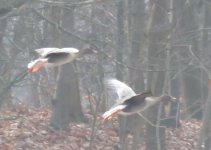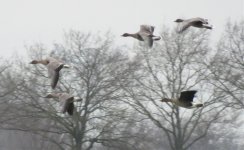Hello Lützen and Frank,
thank you for your answer!
"Please note, that the dark tail band often LOOKS narrower in bad, blurry and overexposed photos (like yours, as allways no offense!) due to photographic "burned-out"-effects."
Not sure I understand what you are saying here. PFG normally have a broader white tailband and more extensive white upper tail coverts than Tundra Bean Geese (TBG), so "burn-out" would make TBG look more like PFG and make it harder to conclude that these are PFG. To me they look better for TBG than PFG even though the angle on many birds makes it difficult to judge.
I was surprised by this, because we both say the same here. One can say that the tail of a Goose is white with a dark tailband or dark, framed white? (Is a Zebra white with black stripes ore black with white stripes?) But I agree, as Frank has spoken of white tail-bands in his first post, so I should better have stayed with this.
I must admit that I was quite sure that the three birds in picture 5 (the picture, which I valuated most: wings not blurred, looking natural not as in picture 1, birds are not flying DIRECTLY away but slightly sidewards) are indeed PFG (two flying and one sitting). So I will write some more thoughts to this birds and hope you answer:
For me, the two birds flying together dont just have pale upperwings, but very pale grey (paler and greyer than the other flying geese in this picture) and reminded me of a Pink-Footed and looked to pale for grey-backed Beans.
And doesnt look the bird sitting below them not good for Pink-Footed? The back seems pale grey and the greater coverts even look paler. In my experience, in those Beans with a grey (not "normal-dark") back the greater coverts are as dark or darker than the rest of the back. While in PFG this pattern is regular.
I have looked at this picture on two screens now. and I understand when someone says that the bill colour cant be judged in a picture of this quality (you cant even be sure that the bill isnt covered by mud), but when you accept the bill colour is real, it SEEMS BETTER for PFG than for Bean?
I must admit that I have looked not very intense, when searching for Taiga Bean in the last years in Brandenburg and Mecklenburg-Vorpommern. I saw some birds, that gave the right swan-like, long-necked impression but have found many birds that I couldnt assign to a (sub)species. So I gave up but I cant remember that I found a difference in head/neck contrast in Bean Goose there: some Bean have a darker head but not marked as in PFG.
But thats the point: I am always keen to learn from more experiencend people like you so one more reason to look at Bean Goose more in depth in the future!
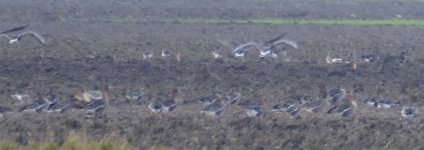 20200110-123331_Fuji-X-T2_DSCF7319.jpg338.3 KB · Views: 201
20200110-123331_Fuji-X-T2_DSCF7319.jpg338.3 KB · Views: 201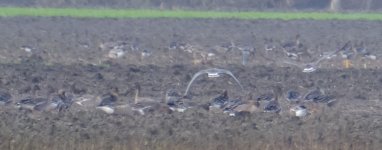 20200110-123314_Fuji-X-T2_DSCF7317_rietgans.jpg277.3 KB · Views: 145
20200110-123314_Fuji-X-T2_DSCF7317_rietgans.jpg277.3 KB · Views: 145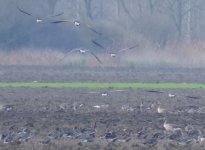 20200110-123331_Fuji-X-T2_DSCF7319_1_rietgans.jpg401.1 KB · Views: 224
20200110-123331_Fuji-X-T2_DSCF7319_1_rietgans.jpg401.1 KB · Views: 224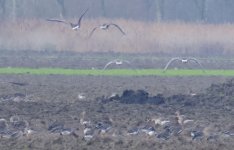 20200110-123331_Fuji-X-T2_DSCF7319_2_rietgans.jpg362.3 KB · Views: 149
20200110-123331_Fuji-X-T2_DSCF7319_2_rietgans.jpg362.3 KB · Views: 149 20200110-123328_Fuji-X-T2_DSCF7318_rietgans.jpg579.9 KB · Views: 137
20200110-123328_Fuji-X-T2_DSCF7318_rietgans.jpg579.9 KB · Views: 137



